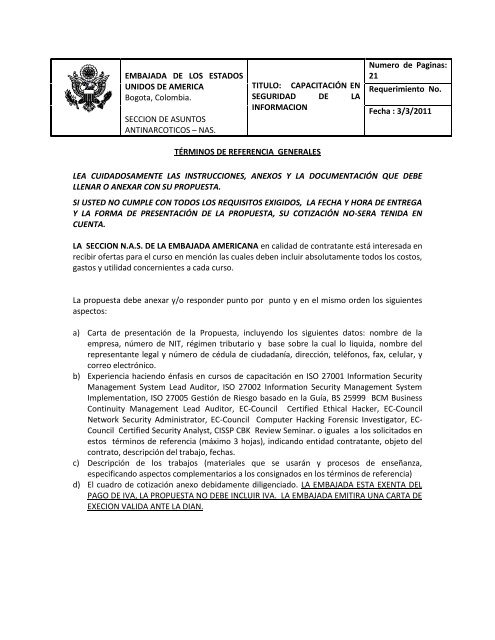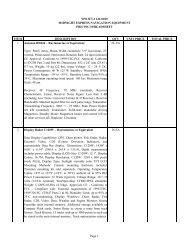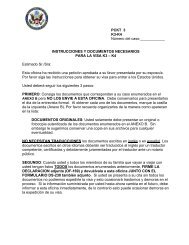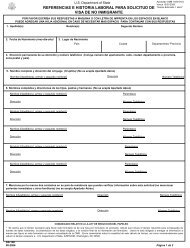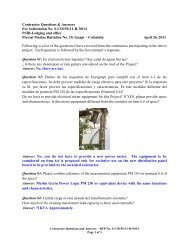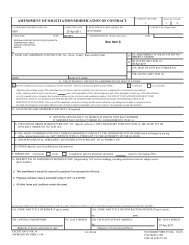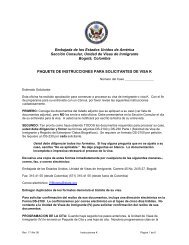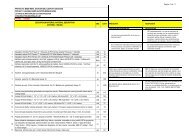EMBAJADA DE LOS ESTADOS UNIDOS DE AMERICA Bogota ...
EMBAJADA DE LOS ESTADOS UNIDOS DE AMERICA Bogota ...
EMBAJADA DE LOS ESTADOS UNIDOS DE AMERICA Bogota ...
Create successful ePaper yourself
Turn your PDF publications into a flip-book with our unique Google optimized e-Paper software.
<strong>EMBAJADA</strong> <strong>DE</strong> <strong>LOS</strong> <strong>ESTADOS</strong><br />
<strong>UNIDOS</strong> <strong>DE</strong> <strong>AMERICA</strong><br />
<strong>Bogota</strong>, Colombia.<br />
SECCION <strong>DE</strong> ASUNTOS<br />
ANTINARCOTICOS – NAS.<br />
TITULO: CAPACITACIÓN EN<br />
SEGURIDAD <strong>DE</strong> LA<br />
INFORMACION<br />
TÉRMINOS <strong>DE</strong> REFERENCIA GENERALES<br />
Numero de Paginas:<br />
21<br />
Requerimiento No.<br />
Fecha : 3/3/2011<br />
LEA CUIDADOSAMENTE LAS INSTRUCCIONES, ANEXOS Y LA DOCUMENTACIÓN QUE <strong>DE</strong>BE<br />
LLENAR O ANEXAR CON SU PROPUESTA.<br />
SI USTED NO CUMPLE CON TODOS <strong>LOS</strong> REQUISITOS EXIGIDOS, LA FECHA Y HORA <strong>DE</strong> ENTREGA<br />
Y LA FORMA <strong>DE</strong> PRESENTACIÓN <strong>DE</strong> LA PROPUESTA, SU COTIZACIÓN NO-SERA TENIDA EN<br />
CUENTA.<br />
LA SECCION N.A.S. <strong>DE</strong> LA <strong>EMBAJADA</strong> <strong>AMERICA</strong>NA en calidad de contratante está interesada en<br />
recibir ofertas para el curso en mención las cuales deben incluir absolutamente todos los costos,<br />
gastos y utilidad concernientes a cada curso.<br />
La propuesta debe anexar y/o responder punto por punto y en el mismo orden los siguientes<br />
aspectos:<br />
a) Carta de presentación de la Propuesta, incluyendo los siguientes datos: nombre de la<br />
empresa, número de NIT, régimen tributario y base sobre la cual lo liquida, nombre del<br />
representante legal y número de cédula de ciudadanía, dirección, teléfonos, fax, celular, y<br />
correo electrónico.<br />
b) Experiencia haciendo énfasis en cursos de capacitación en ISO 27001 Information Security<br />
Management System Lead Auditor, ISO 27002 Information Security Management System<br />
Implementation, ISO 27005 Gestión de Riesgo basado en la Guía, BS 25999 BCM Business<br />
Continuity Management Lead Auditor, EC-Council Certified Ethical Hacker, EC-Council<br />
Network Security Administrator, EC-Council Computer Hacking Forensic Investigator, EC-<br />
Council Certified Security Analyst, CISSP CBK Review Seminar. o iguales a los solicitados en<br />
estos términos de referencia (máximo 3 hojas), indicando entidad contratante, objeto del<br />
contrato, descripción del trabajo, fechas.<br />
c) Descripción de los trabajos (materiales que se usarán y procesos de enseñanza,<br />
especificando aspectos complementarios a los consignados en los términos de referencia)<br />
d) El cuadro de cotización anexo debidamente diligenciado. LA <strong>EMBAJADA</strong> ESTA EXENTA <strong>DE</strong>L<br />
PAGO <strong>DE</strong> IVA, LA PROPUESTA NO <strong>DE</strong>BE INCLUIR IVA. LA <strong>EMBAJADA</strong> EMITIRA UNA CARTA <strong>DE</strong><br />
EXECION VALIDA ANTE LA DIAN.
REQUERIMIENTOS PARA LA CAPACITACIÓN EN ISO 27001 INFORMATION SECURITY<br />
MANAGEMENT SYSTEM LEAD AUDITOR, ISO 27002 INFORMATION SECURITY MANAGEMENT<br />
SYSTEM IMPLEMENTATION, ISO 27005 GESTIÓN <strong>DE</strong> RIESGO BASADO EN LA GUÍA, BS 25999<br />
BCM BUSINESS CONTINUITY MANAGEMENT LEAD AUDITOR, EC-COUNCIL CERTIFIED ETHICAL<br />
HACKER, EC-COUNCIL NETWORK SECURITY ADMINISTRATOR, EC-COUNCIL COMPUTER<br />
HACKING FORENSIC INVESTIGATOR, EC-COUNCIL CERTIFIED SECURITY ANALYST, CISSP CBK<br />
REVIEW SEMINAR.<br />
1. JUSTIFICACIÓN<br />
CONDICIONES GENERALES<br />
Es necesaria la capacitación en el desarrollo de competencias técnicas como es la<br />
implementación y administración de redes y sistemas para detectar riesgos y vulnerabilidades,<br />
realizar auditorías, fijar políticas y estándares de seguridad, analizar protocolos y seguridad<br />
física,, además de realizar computación forense, para prestar el soporte a las necesidades de<br />
ingeniería de sistemas en la Dirección de Antinarcóticos Dirección de Carabineros y Oficina de<br />
Telemática de la Policia Nacional en las cuales el personal de sistemas y comunicaciones no está<br />
calificado para el servicio que se requiere.<br />
2. FINALIDAD<br />
Seleccionar la mejor entidad o persona especializada que cumpla los requisitos para brindar la<br />
capacitación requerida en ISO 27001 Information Security Management System Lead Auditor,<br />
ISO 27002 Information Security Management System Implementation, ISO 27005 Gestión de<br />
Riesgo basado en la Guía, BS 25999 BCM Business Continuity Management Lead Auditor,<br />
EC-Council Certified Ethical Hacker,EC-Council Network Security Administrator, EC-Council<br />
Computer Hacking Forensic Investigator, EC-Council Certified Security Analyst y CISSP CBK<br />
Review Seminar para que garantice una excelente capacitación al personal de estudiantes de la<br />
Policía Nacional.<br />
3. <strong>DE</strong>SCRIPCIÓN <strong>DE</strong>L SERVICIO<br />
Capacitar en Seguridad de la información en nueve (9) cursos con una intensidad horaria,<br />
participantes y costos Totales de acuerdo al Anexo A. para la verificación de la información y<br />
calidad en las instalaciones, aulas y ayudas un delegado de la Embajada visitara las instalaciones<br />
de los oferentes.<br />
4. CARACTERÍSTICAS <strong>DE</strong> LA CAPACITACIÓN Y CONTENIDO TEMÁTICO<br />
El entrenamiento debe proporcionar a los estudiantes las habilidades y conocimientos<br />
necesarios para asegurar la confidencialidad y protección de los datos que circulan por la red de<br />
datos de la policia nacional, localizar y mitigar los riesgos y vulnerabilidades, realizar auditorías y<br />
diagnósticos; El valor debe incluir prácticas en equipos y materiales, Laboratorios de Práctica<br />
Reales; los instructores deben ser certificados con varios años de experiencia y adicionalmente<br />
certificados para ser instructor.
5. TEMAS A TRATAR EN LA CAPACITACIÓN<br />
5.1 CURS0 ISO 27001<br />
CONTENIDO <strong>DE</strong>L CURSO<br />
� Review the requirements of ISO/IEC 27001<br />
� Understand the relationship between ISO/IEC 27001 and ISO/IEC 27002<br />
� Learn how to assess security threats and vulnerabilities<br />
� Understand security controls and countermeasures<br />
� Understand the roles and responsibilities of the auditor<br />
� Learn how to, plan, execute, report, and follow-up on an information security<br />
management system audit<br />
5.2 CURSO ISO 27002<br />
CONTENIDO <strong>DE</strong>L CURSO<br />
Understand the specific requirements for an ISMS<br />
� Identify uses of ISMS controls<br />
� Determine and assess risk to information security<br />
� Determine the value of information assets<br />
� Understand the design and implementation of an ISMS<br />
� Understand definitions of policies, standards, and procedures<br />
� Recognize the importance of auditing and reviewing an ISMS<br />
� Understand ISMS documentation<br />
� Understand the implementation process<br />
5.3 CURSO SEGURIDAD <strong>DE</strong> LA INFORMACIÓN ADMINISTRACIÓN <strong>DE</strong>L RIESGO ISO<br />
27005<br />
CONTENIDO <strong>DE</strong>L CURSO<br />
� Foreword<br />
� Introduction<br />
� Normative references<br />
� Terms and definitions<br />
� Structure of this International Standard<br />
� Background<br />
� Overview of the information security risk management process<br />
� Context establishment<br />
� General considerations<br />
� Basic Criteria<br />
� The scope and boundaries
� Organization for information security risk management<br />
� Information security risk assessment<br />
� General description of information security risk assessment<br />
� Risk analysis<br />
� Risk identification<br />
� Risk estimation<br />
� Risk evaluation<br />
� Information security risk treatment<br />
� General description of risk treatment<br />
� Risk reduction<br />
� Risk retention<br />
� Risk avoidance<br />
� Risk transfer<br />
� Information security risk acceptance<br />
� Information security risk communication<br />
� Information security risk monitoring and review<br />
� Monitoring and review of risk factors<br />
� Risk management monitoring, reviewing and improving<br />
� Defining the scope and boundaries of the information security risk management process<br />
� Study of the organization<br />
� List of the constraints affecting the organization<br />
� List of the legislative and regulatory references applicable to the organization<br />
� List of the constraints affecting the scope<br />
� Identification and valuation of assets and impact assessment<br />
� Examples of asset identification<br />
� The identification of primary assets<br />
� List and description of supporting assets<br />
� Asset valuation<br />
� Impact assessment<br />
� Examples of typical threats<br />
� Vulnerabilities and methods for vulnerability assessment<br />
� Examples of vulnerabilities<br />
� Methods for assessment of technical vulnerabilities<br />
� Information security risk assessment approaches<br />
� High-level information security risk assessment<br />
� Detailed information security risk assessment<br />
� Matrix with predefined values<br />
� Ranking of Threats by Measures of Risk<br />
� Assessing a value for the likelihood and the possible consequences of risks<br />
� Constraints for risk reduction<br />
5.4 CURSO BS 25999<br />
CONTENIDO <strong>DE</strong>L CURSO
� Lead an audit of a business continuity management system<br />
� Carry out an audit of a business continuity management system<br />
� Clarify the different purposes of BS 25999 Part 1 and Part 2<br />
� Explain the requirements of BS 25999-2:2007<br />
� Understand the Business Continuity Management Code of Practice BS 25999-1:2006<br />
� Articulate and present audit findings<br />
� Manage successful audit communication and interviews<br />
� Write a succinct audit report<br />
� Conduct opening, closing, and follow-up audit meetings<br />
5.5 CURSO CEH<br />
CONTENIDO <strong>DE</strong>L CURSO<br />
� Module 1: Introduction to Ethical Hacking<br />
� Module 2: Hacking Laws<br />
� Module 3: Footprinting<br />
� Module 4: Google Hacking<br />
� Module 5: Scanning<br />
� Module 6: Enumeration<br />
� Module 8: Trojans and Backdoors<br />
� Module 9: Viruses and Worms<br />
� Module 10: Sniffers<br />
� Module 11: Social Engineering<br />
� Module 12: Phishing<br />
� Module 13: Hacking Email Accounts<br />
� Module 14: Denial-of-Service<br />
� Module 15: Session Hijacking<br />
� Module 16: Hacking Web Servers<br />
� Module 17: Web Application Vulnerabilities<br />
� Module 18: Web-Based Password Cracking Techniques<br />
� Module 19: SQL Injection<br />
� Module 20: Hacking Wireless Networks<br />
� Module 21: Physical Security<br />
� Module 22: Linux Hacking<br />
� Module 23: Evading IDS, Firewalls and Detecting Honey Pots<br />
� Module 24: Buffer Overfl ows<br />
� Module 25: Cryptography<br />
� Module 26: Penetration Testing<br />
� Module 27: Covert Hacking<br />
� Module 28: Writing Virus Codes<br />
� Module 29: Assembly Language Tutorial<br />
� Module 30: Exploit Writing<br />
� Module 31: Smashing the Stack for Fun and Profi t<br />
� Module 32: Windows Based Buffer Overfl ow Exploit Writing
� Module 33: Reverse Engineering<br />
� Module 34: MAC OS X Hacking<br />
� Module 35: Hacking Routers, cable Modems and Firewalls<br />
� Module 36: Hacking Mobile Phones, PDA and Handheld Devices<br />
� Module 37: Bluetooth Hacking<br />
� Module 38: VoIP Hacking<br />
� Module 39: RFID Hacking<br />
� Module 40: Spamming<br />
� Module 41: Hacking USB Devices<br />
� Module 42: Hacking Database Servers<br />
� Module 43: Cyber Warfare- Hacking, Al-Qaida and Terrorism<br />
� Module 44: Internet Content Filtering Techniques<br />
� Module 45: Privacy on the Internet<br />
� Module 46: Securing Laptop Computers<br />
� Module 47: Spying Technologies<br />
� Module 48: Corporate Espionage- Hacking Using Insiders<br />
� Module 49: Creating Security Policies<br />
� Module 50: Software Piracy and Warez<br />
� Module 51: Hacking and Cheating Online Games<br />
� Module 52: Hacking RSS and Atom<br />
� Module 53: Hacking Web Browsers (Firefox, IE)<br />
� Module 54: Proxy Server Technologies<br />
� Module 55: Data Loss Prevention<br />
� Module 56: Hacking Global Positioning System (GPS)<br />
� Module 57: Computer Forensics and Incident Handling<br />
� Module 58: Credit Card Frauds<br />
� Module 59: How to Steal Passwords<br />
� Module 60: Firewall Technologies<br />
� Module 61: Threats and Countermeasures<br />
� Module 62: Case Studies<br />
5.6 CURSO ENSA<br />
CONTENIDO <strong>DE</strong>L CURSO<br />
� Module I: Fundamentos de redes<br />
� Module II: Protocolos de red<br />
� Module III: Análisis de Protocolos<br />
� Module IV: Estándares IEEE<br />
� Module V: Seguridad en Redes<br />
� Module VI: Organismos de Estándares de Seguridad<br />
� Module VII: Estándares de Seguridad<br />
� Module VIII: Políticas de Seguridad<br />
� Module IX: Seguridad Física<br />
� Module X: Amenazas de Seguridad
� Module XI: Sistema de Detección de Intrusos (IDS) y Sistemas de Prevención de Intrusos<br />
(IPS)<br />
� Module XIII: Packet Filtering<br />
� Module XIV: Seguridad en Modems<br />
� Module XV: Hardening Routers<br />
� Module XVI: Hardening Operating Systems<br />
� Module XVII: Patch Management<br />
� Module XVIII: Análisis de Logs<br />
� Module XIX : Application Security<br />
� Module XX: Seguridad WEB<br />
� Module XXI: E-mail Security<br />
� Module XXII: Autenticación, Encripción, Criptografía y Firmas Digitales.<br />
� Module XXIII: Wireless Network Security<br />
� Module XXIV: Creating Fault Tolerance<br />
� Module XXV: Respuesta ante Incidentes<br />
� Module XXVI: Recuperación ante Desastres y Planeación<br />
� Module XXVII: Network Vulnerability Assessment<br />
5.7 CURSO CHFI<br />
CONTENIDO <strong>DE</strong>L CURSO<br />
� Module 01: Computer Forensics in Today’s World<br />
� Module 02: Computer Forensics Investigation Process<br />
� Module 03: Searching and Seizing of Computers<br />
� Module 04: Digital Evidence<br />
� Module 05: First Responder Procedures<br />
� Module 06: Incident Handling<br />
� Module 07: Computer Forensics Lab<br />
� Module 08: Understanding Hard Disks and File Systems<br />
� Module 09: Digital Media Devices<br />
� Module 10: CD/DVD Forensics<br />
� Module 11: Windows Linux Macintosh Boot Process<br />
� Module 12: Windows Forensics I<br />
� Module 13: Windows Forensics II<br />
� Module 14: Linux Forensics<br />
� Module 15: Mac Forensics<br />
� Module 16: Data Acquisition and Duplication<br />
� Module 17: Recovering Deleted Files and Deleted Partitions<br />
� Module 18: Forensics Investigations Using AccessData FTK<br />
� Module 19: Forensics Investigations Using Encase<br />
� Module 20: Steganography<br />
� Module 21: Image Files Forensics<br />
� Module 22: Audio file forensics<br />
� Module 23: Video File Forensics<br />
� Module 24: Application Password Crackers
� Module 25: Log Capturing and Event Correlation<br />
� Module 26: Network Forensics and Investigating Logs<br />
� Module 27: Investigating Network Traffic<br />
� Module 28: Router Forensics<br />
� Module 29: Investigating Wireless Attacks<br />
� Module 30: Investigating Web Attacks<br />
� Module 31: Investigating DoS Attacks<br />
� Module 32: Investigating virus, Trojan, spyware and Rootkit Attacks<br />
� Module 33: Investigating Internet Crimes<br />
� Module 34: Tracking Emails and Investigating Email crimes<br />
� Module 35: PDA Forensics<br />
� Module 36: Blackberry Forensics<br />
� Module 37: iPod and iPhone Forensics<br />
� Module 38: Cell Phone Forensics<br />
� Module 39: USB Forensics<br />
� Module 40: Printer Forensics<br />
� Module 41: Investigating Corporate Espionage<br />
� Module 42: Investigating Computer Data Breaches<br />
� Module 43: Investigating Trademark and Copyright Infringement<br />
� Module 44: Investigating Sexual Harassment Incidents<br />
� Module 45: Investigating Child Pornography Cases<br />
� Module 46: Investigating Identity Theft Cases<br />
� Module 47: Investigating Defamation over Websites and Blog Postings<br />
� Module 48: Investigating Social Networking Websites for Evidences<br />
� Module 49: Investigation Search Keywords<br />
� Module 50: Investigative Reports<br />
� Module 51: Becoming an Expert Witness<br />
� Module 52: How to Become a Digital Detective<br />
� Module 53: Computer Forensics for Lawyers<br />
� Module 54: Law and Computer Forensics<br />
� Module 55: Computer Forensics and Legal Compliance<br />
� Module 56: Security Policies<br />
� Module 57: Risk Assessment<br />
� Module 58: Evaluation and Certification of Information Systems<br />
� Module 59: Ethics in Computer Forensics<br />
� Module 60: Computer Forensic Tools<br />
� Module 61: Windows Based Command Line Tools<br />
� Module 62: Windows Based GUI Tools<br />
� Module 63: Forensics Frameworks<br />
� Module 64: Forensics Investigation Templates<br />
� Module 65: Computer Forensics Consulting Companies<br />
5.8 CURSO ECSA<br />
CONTENIDO <strong>DE</strong>L CURSO
� Module 01: Computer Forensics in Today’s World<br />
� Module 02: Computer Forensics Investigation Process<br />
� Module 03: Searching and Seizing of Computers<br />
� Module 04: Digital Evidence<br />
� Module 05: First Responder Procedures<br />
� Module 06: Incident Handling<br />
� Module 07: Computer Forensics Lab<br />
� Module 08: Understanding Hard Disks and File Systems<br />
� Module 09: Digital Media Devices<br />
� Module 10: CD/DVD Forensics<br />
� Module 11: Windows Linux Macintosh Boot Process<br />
� Module 12: Windows Forensics I<br />
� Module 13: Windows Forensics II<br />
� Module 14: Linux Forensics<br />
� Module 15: Mac Forensics<br />
� Module 16: Data Acquisition and Duplication<br />
� Module 17: Recovering Deleted Files and Deleted Partitions<br />
� Module 18: Forensics Investigations Using AccessData FTK<br />
� Module 19: Forensics Investigations Using Encase<br />
� Module 20: Steganography<br />
� Module 21: Image Files Forensics<br />
� Module 22: Audio file forensics<br />
� Module 23: Video File Forensics<br />
� Module 24: Application Password Crackers<br />
� Module 25: Log Capturing and Event Correlation<br />
� Module 26: Network Forensics and Investigating Logs<br />
� Module 27: Investigating Network Traffic<br />
� Module 28: Router Forensics<br />
� Module 29: Investigating Wireless Attacks<br />
� Module 30: Investigating Web Attacks<br />
� Module 31: Investigating DoS Attacks<br />
� Module 32: Investigating virus, Trojan, spyware and Rootkit Attacks<br />
� Module 33: Investigating Internet Crimes<br />
� Module 34: Tracking Emails and Investigating Email crimes<br />
� Module 35: PDA Forensics<br />
� Module 36: Blackberry Forensics<br />
� Module 37: iPod and iPhone Forensics<br />
� Module 38: Cell Phone Forensics<br />
� Module 39: USB Forensics<br />
� Module 40: Printer Forensics<br />
� Module 41: Investigating Corporate Espionage<br />
� Module 42: Investigating Computer Data Breaches<br />
� Module 43: Investigating Trademark and Copyright Infringement<br />
� Module 44: Investigating Sexual Harassment Incidents<br />
� Module 45: Investigating Child Pornography Cases<br />
� Module 46: Investigating Identity Theft Cases
� Module 47: Investigating Defamation over Websites and Blog Postings<br />
� Module 48: Investigating Social Networking Websites for Evidences<br />
� Module 49: Investigation Search Keywords<br />
� Module 50: Investigative Reports<br />
� Module 51: Becoming an Expert Witness<br />
� Module 52: How to Become a Digital Detective<br />
� Module 53: Computer Forensics for Lawyers<br />
� Module 54: Law and Computer Forensics<br />
� Module 55: Computer Forensics and Legal Compliance<br />
� Module 56: Security Policies<br />
� Module 57: Risk Assessment<br />
� Module 58: Evaluation and Certification of Information Systems<br />
� Module 59: Ethics in Computer Forensics<br />
� Module 60: Computer Forensic Tools<br />
� Module 61: Windows Based Command Line Tools<br />
� Module 62: Windows Based GUI Tools<br />
� Module 63: Forensics Frameworks<br />
� Module 64: Forensics Investigation Templates<br />
� Module 65: Computer Forensics Consulting Companies<br />
5.9 CURSO CISSP<br />
CONTENIDO <strong>DE</strong>L CURSO<br />
� Access Control - a collection of mechanisms that work together to create security<br />
architecture to protect the assets of the information system.<br />
� Application Development Security - addresses the important security concepts that<br />
apply to application software development. It outlines the environment where software<br />
is designed and developed and explains the critical role software plays in providing<br />
information system security.<br />
� Business Continuity and Disaster Recovery Planning – for the preservation and recovery<br />
of business operations in the event of outages.<br />
� Cryptography - the principles, means, and methods of disguising information to ensure<br />
its integrity, confidentiality and authenticity.<br />
� Information Security Governance and Risk Management - the identification of an<br />
organization’s information assets and the development, documentation, and<br />
implementation of policies, standards, procedures, and guidelines. Management tools<br />
such as data classification and risk assessment/analysis are used to identify threats,<br />
classify assets, and to rate system vulnerabilities so that effective controls can be<br />
implemented.<br />
� Legal, Regulations, Investigations and Compliance - Computer crime laws and<br />
regulations. The measures and technologies used to investigate computer crime<br />
incidents<br />
� Operations Security - used to identify the controls over hardware, media, and the<br />
operators and administrators with access privileges to any of these resources. Audit and
monitoring are the mechanisms, tools, and facilities that permit the identification of<br />
security events and subsequent actions to identify the key elements and report the<br />
pertinent information to the appropriate individual, group, or process.<br />
� Physical (Environmental) Security - provides protection techniques for the entire facility,<br />
from the outside perimeter to the inside office space, including all of the information<br />
system resources.<br />
� Security Architecture and Design - contains the concepts, principles, structures, and<br />
standards used to design, monitor, and secure operating systems, equipment, networks,<br />
applications and those controls used to enforce various levels of availability, integrity,<br />
and confidentiality.<br />
� Telecommunications and Network Security<br />
� Network structures<br />
� Transmission methods<br />
� Transport formats<br />
� Security measures used to provide availability, integrity, and confidentiality<br />
� Authentication for transmissions over private and public communications networks and<br />
media<br />
6. LUGAR <strong>DE</strong> EJECUCIÓN <strong>DE</strong>L CONTRATO<br />
El contrato se ejecutara en la ciudad de <strong>Bogota</strong>, Colombia en las instalaciones del contratista en<br />
el horario de 8:00 AM a 6:00 PM de lunes a viernes y/o lo coordinado con el jefe de Telemática<br />
de la Policía Nacional.<br />
7. CERTIFICACION<br />
Se otorgará una certificación por una entidad reconocida en entrenamiento, a cada uno de los<br />
estudiantes que completen cada curso en un 90%<br />
8. MATERIALES<br />
La entidad contratista suministrará los materiales oficiales que se requieran para cada clase y<br />
estudiante; completamente originales, no se aceptaran copias y/o fotocopias del material de<br />
estudio; también se proporcionaran todos los materiales para las practicas requeridas en los<br />
ejercicios propuestos por el programa de acuerdo al método entregado por la entidad<br />
contratista.<br />
9. CUADRO <strong>DE</strong> EVALUACION<br />
Para la evaluación de las ofertas se tendrá en cuenta el siguiente cuadro, el cual deberá<br />
diligenciar el oferente indicando si ofrece lo solicitado y o anexa la documentación requerida, la<br />
cual sustenta la oferta.<br />
ITEM<br />
1 CURS0 ISO 27001<br />
<strong>DE</strong>SCRIPCION<br />
(PLIEGO SOLICITADO POR LA <strong>EMBAJADA</strong>)<br />
OFERENTE<br />
XXX
1.1 Review the requirements of ISO/IEC 27001<br />
1.2 Understand the relationship between ISO/IEC 27001 and ISO/IEC 27002<br />
1.3 Learn how to assess security threats and vulnerabilities<br />
1.4 Understand security controls and countermeasures<br />
1.5 Understand the roles and responsibilities of the auditor<br />
1.6<br />
Learn how to, plan, execute, report, and follow-up on an information security<br />
management system audit<br />
1.7 Cantidad de participantes: 10<br />
1.8 Certificacion como auditor lider ISO 27001:2005<br />
1.9 Duracion : 40 horas<br />
2 CURSO ISO 27002<br />
2.1 Understand the specific requirements for an ISMS<br />
2.2 Identify uses of ISMS controls<br />
2.3 Determine and assess risk to information security<br />
2.4 Determine the value of information assets<br />
2.5 Understand the design and implementation of an ISMS<br />
2.6 Understand definitions of policies, standards, and procedures<br />
2.7 Recognize the importance of auditing and reviewing an ISMS<br />
2.8 Understand ISMS documentation<br />
2.9 Understand the implementation process<br />
2.10 Cantidad de participantes: 10<br />
2.11 Certificacion: En adquisicion de conocimientos<br />
2.12 Duracion : 32 horas<br />
3<br />
CURSO SEGURIDAD <strong>DE</strong> LA INFORMACIÓN ADMINISTRACIÓN <strong>DE</strong>L RIESGO ISO<br />
27005<br />
3.1 Foreword<br />
3.2 Introduction<br />
3.3 Normative references<br />
3.4 Terms and definitions<br />
3.5 Structure of this International Standard<br />
3.6 Background<br />
3.7 Overview of the information security risk management process<br />
3.8 Context establishment<br />
3.9 General considerations<br />
3.10 Basic Criteria<br />
3.11 The scope and boundaries<br />
3.12 Organization for information security risk management<br />
3.13 Information security risk assessment<br />
3.14 General description of information security risk assessment<br />
3.15 Risk analysis<br />
3.16 Risk identification
3.17 Risk estimation<br />
3.18 Risk evaluation<br />
3.19 Information security risk treatment<br />
3.20 General description of risk treatment<br />
3.21 Risk reduction<br />
3.22 Risk retention<br />
3.23 Risk avoidance<br />
3.24 Risk transfer<br />
3.25 Information security risk acceptance<br />
3.26 Information security risk communication<br />
3.27 Information security risk monitoring and review<br />
3.28 Monitoring and review of risk factors<br />
3.29 Risk management monitoring, reviewing and improving<br />
3.30<br />
Defining the scope and boundaries of the information security risk management<br />
process<br />
3.31 Study of the organization<br />
3.32 List of the constraints affecting the organization<br />
3.33 List of the legislative and regulatory references applicable to the organization<br />
3.34 List of the constraints affecting the scope<br />
3.35 Identification and valuation of assets and impact assessment<br />
3.36 Examples of asset identification<br />
3.37 The identification of primary assets<br />
3.38 List and description of supporting assets<br />
3.39 Asset valuation<br />
3.40 Impact assessment<br />
3.41 Examples of typical threats<br />
3.42 Vulnerabilities and methods for vulnerability assessment<br />
3.43 Examples of vulnerabilities<br />
3.44 Methods for assessment of technical vulnerabilities<br />
3.45 Information security risk assessment approaches<br />
3.46 High-level information security risk assessment<br />
3.47 Detailed information security risk assessment<br />
3.48 Matrix with predefined values<br />
3.49 Ranking of Threats by Measures of Risk<br />
3.50 Assessing a value for the likelihood and the possible consequences of risks<br />
3.51 Constraints for risk reduction<br />
3.52 Cantidad de participantes: 5<br />
3.53 Certificacion: En adquisicion de conocimientos<br />
3.54 Duracion : 16 horas<br />
4 CURSO BS 25999<br />
4.1 Lead an audit of a business continuity management system
4.2 Carry out an audit of a business continuity management system<br />
4.3 Clarify the different purposes of BS 25999 Part 1 and Part 2<br />
4.4 Explain the requirements of BS 25999-2:2007<br />
4.5<br />
Understand the Business Continuity Management Code of Practice BS 25999-<br />
1:2006<br />
4.6 Articulate and present audit findings<br />
4.7 Manage successful audit communication and interviews<br />
4.8 Write a succinct audit report<br />
4.9 Conduct opening, closing, and follow-up audit meetings<br />
4.10 Cantidad de participantes: 5<br />
4.11<br />
Certificacion: Como auditor lider de la gestion de continuidad del negocio BS<br />
25999<br />
4.12 Duracion : 40 horas<br />
5 CURSO CEH<br />
5.1 Module 1: Introduction to Ethical Hacking<br />
5.2 Module 2: Hacking Laws�<br />
5.3 Module 3: Footprinting<br />
5.4 Module 4: Google Hacking<br />
5.5 Module 5: Scanning<br />
5.6 Module 6: Enumeration<br />
5.7 Module 8: Trojans and Backdoors<br />
5.8 Module 9: Viruses and Worms<br />
5.9 Module 10: Sniffers<br />
5.10 Module 11: Social Engineering<br />
5.11 Module 12: Phishing<br />
5.12 Module 13: Hacking Email Accounts<br />
5.13 Module 14: Denial-of-Service<br />
5.14 Module 15: Session Hijacking<br />
5.15 Module 16: Hacking Web Servers<br />
5.16 Module 17: Web Application Vulnerabilities<br />
5.17 Module 18: Web-Based Password Cracking Techniques<br />
5.18 Module 19: SQL Injection<br />
5.19 Module 20: Hacking Wireless Networks<br />
5.20 Module 21: Physical Security<br />
5.21 Module 22: Linux Hacking<br />
5.22 Module 23: Evading IDS, Firewalls and Detecting Honey Pots<br />
5.23 Module 24: Buffer Overfl ows<br />
5.24 Module 25: Cryptography<br />
5.25 Module 26: Penetration Testing<br />
5.26 Module 27: Covert Hacking<br />
5.27 Module 28: Writing Virus Codes
5.28 Module 29: Assembly Language Tutorial<br />
5.29 Module 30: Exploit Writing<br />
5.30 Module 31: Smashing the Stack for Fun and Profi t<br />
5.31 Module 32: Windows Based Buffer Overfl ow Exploit Writing<br />
5.32 Module 33: Reverse Engineering<br />
5.33 Module 34: MAC OS X Hacking<br />
5.34 Module 35: Hacking Routers, cable Modems and Firewalls<br />
5.35 Module 36: Hacking Mobile Phones, PDA and Handheld Devices<br />
5.36 Module 37: Bluetooth Hacking<br />
5.37 Module 38: VoIP Hacking<br />
5.38 Module 39: RFID Hacking<br />
5.39 Module 40: Spamming<br />
5.40 Module 41: Hacking USB Devices<br />
5.41 Module 42: Hacking Database Servers<br />
5.42 Module 43: Cyber Warfare- Hacking, Al-Qaida and Terrorism<br />
5.43 Module 44: Internet Content Filtering Techniques<br />
5.44 Module 45: Privacy on the Internet<br />
5.45 Module 46: Securing Laptop Computers<br />
5.46 Module 47: Spying Technologies<br />
5.47 Module 48: Corporate Espionage- Hacking Using Insiders<br />
5.48 Module 49: Creating Security Policies<br />
5.49 Module 50: Software Piracy and Warez<br />
5.50 Module 51: Hacking and Cheating Online Games<br />
5.51 Module 52: Hacking RSS and Atom<br />
5.52 Module 53: Hacking Web Browsers (Firefox, IE)<br />
5.53 Module 54: Proxy Server Technologies<br />
5.54 Module 55: Data Loss Prevention<br />
5.55 Module 56: Hacking Global Positioning System (GPS)<br />
5.56 Module 57: Computer Forensics and Incident Handling<br />
5.57 Module 58: Credit Card Frauds<br />
5.58 Module 59: How to Steal Passwords<br />
5.59 Module 60: Firewall Technologies<br />
5.60 Module 61: Threats and Countermeasures<br />
5.61 Module 62: Case Studies<br />
5.62 Cantidad de participantes: 10<br />
5.63 Certificacion: En CEH del EC COUNCIL<br />
5.64 Duracion : 45 horas<br />
6 CURSO ENSA<br />
6.1 Module I: Fundamentos de redes<br />
6.2 Module II: Protocolos de red<br />
6.3 Module III: Análisis de Protocolos
6.4 Module IV: Estándares IEEE<br />
6.5 Module V: Seguridad en Redes<br />
6.6 Module VI: Organismos de Estándares de Seguridad<br />
6.7 Module VII: Estándares de Seguridad<br />
6.8 Module VIII: Políticas de Seguridad<br />
6.9 Module IX: Seguridad Física<br />
6.10 Module X: Amenazas de Seguridad<br />
6.11<br />
Module XI: Sistema de Detección de Intrusos (IDS) y Sistemas de Prevención de<br />
Intrusos (IPS)<br />
6.12 Module XIII: Packet Filtering<br />
6.13 Module XIV: Seguridad en Modems<br />
6.14 Module XV: Hardening Routers<br />
6.15 Module XVI: Hardening Operating Systems<br />
6.16 Module XVII: Patch Management<br />
6.17 Module XVIII: Análisis de Logs<br />
6.18 Module XIX : Application Security<br />
6.19 Module XX: Seguridad WEB<br />
6.20 Module XXI: E-mail Security<br />
6.21 Module XXII: Autenticación, Encripción, Criptografía y Firmas Digitales.<br />
6.22 Module XXIII: Wireless Network Security<br />
6.23 Module XXIV: Creating Fault Tolerance<br />
6.24 Module XXV: Respuesta ante Incidentes<br />
6.25 Module XXVI: Recuperación ante Desastres y Planeación<br />
6.26 Module XXVII: Network Vulnerability Assessment<br />
6.27 Cantidad de participantes: 10<br />
6.28 Certificacion: En ENSA del EC COUNCIL<br />
6.29 Duracion : 45 horas<br />
7 CURSO CHFI<br />
7.1 Module 01: Computer Forensics in Today’s World<br />
7.2 Module 02: Computer Forensics Investigation Process<br />
7.3 Module 03: Searching and Seizing of Computers<br />
7.4 Module 04: Digital Evidence<br />
7.5 Module 05: First Responder Procedures<br />
7.6 Module 06: Incident Handling<br />
7.7 Module 07: Computer Forensics Lab<br />
7.8 Module 08: Understanding Hard Disks and File Systems<br />
7.9 Module 09: Digital Media Devices<br />
7.10 Module 10: CD/DVD Forensics
7.11 Module 11: Windows Linux Macintosh Boot Process<br />
7.12 Module 12: Windows Forensics I<br />
7.13 Module 13: Windows Forensics II<br />
7.14 Module 14: Linux Forensics<br />
7.15 Module 15: Mac Forensics<br />
7.16 Module 16: Data Acquisition and Duplication<br />
7.17 Module 17: Recovering Deleted Files and Deleted Partitions<br />
7.18 Module 18: Forensics Investigations Using AccessData FTK<br />
7.19 Module 19: Forensics Investigations Using Encase<br />
7.20 Module 20: Steganography<br />
7.21 Module 21: Image Files Forensics<br />
7.22 Module 22: Audio file forensics<br />
7.23 Module 23: Video File Forensics<br />
7.24 Module 24: Application Password Crackers<br />
7.25 Module 25: Log Capturing and Event Correlation<br />
7.26 Module 26: Network Forensics and Investigating Logs<br />
7.27 Module 27: Investigating Network Traffic<br />
7.28 Module 28: Router Forensics<br />
7.29 Module 29: Investigating Wireless Attacks<br />
7.30 Module 30: Investigating Web Attacks<br />
7.31 Module 31: Investigating DoS Attacks<br />
7.32 Module 32: Investigating virus, Trojan, spyware and Rootkit Attacks<br />
7.33 Module 33: Investigating Internet Crimes<br />
7.34 Module 34: Tracking Emails and Investigating Email crimes<br />
7.35 Module 35: PDA Forensics<br />
7.36 Module 36: Blackberry Forensics<br />
7.37 Module 37: iPod and iPhone Forensics<br />
7.38 Module 38: Cell Phone Forensics<br />
7.39 Module 39: USB Forensics<br />
7.40 Module 40: Printer Forensics<br />
7.41 Module 41: Investigating Corporate Espionage<br />
7.42 Module 42: Investigating Computer Data Breaches<br />
7.43 Module 43: Investigating Trademark and Copyright Infringement<br />
7.44 Module 44: Investigating Sexual Harassment Incidents<br />
7.45 Module 45: Investigating Child Pornography Cases<br />
7.46 Module 46: Investigating Identity Theft Cases<br />
7.47 Module 47: Investigating Defamation over Websites and Blog Postings<br />
7.48 Module 48: Investigating Social Networking Websites for Evidences<br />
7.49 Module 49: Investigation Search Keywords<br />
7.50 Module 50: Investigative Reports<br />
7.51 Module 51: Becoming an Expert Witness
7.52 Module 52: How to Become a Digital Detective<br />
7.53 Module 53: Computer Forensics for Lawyers<br />
7.54 Module 54: Law and Computer Forensics<br />
7.55 Module 55: Computer Forensics and Legal Compliance<br />
7.56 Module 56: Security Policies<br />
7.57 Module 57: Risk Assessment<br />
7.58 Module 58: Evaluation and Certification of Information Systems<br />
7.59 Module 59: Ethics in Computer Forensics<br />
7.60 Module 60: Computer Forensic Tools<br />
7.61 Module 61: Windows Based Command Line Tools<br />
7.62 Module 62: Windows Based GUI Tools<br />
7.63 Module 63: Forensics Frameworks<br />
7.64 Module 64: Forensics Investigation Templates<br />
7.65 Module 65: Computer Forensics Consulting Companies<br />
7.66 Cantidad de participantes: 10<br />
7.67 Certificacion: En CHFI del EC COUNCIL<br />
7.68 Duracion : 45 horas<br />
8 CURSO ECSA<br />
8.1 Module 01: Computer Forensics in Today’s World<br />
8.2 Module 02: Computer Forensics Investigation Process<br />
8.3 Module 03: Searching and Seizing of Computers<br />
8.4 Module 04: Digital Evidence<br />
8.5 Module 05: First Responder Procedures<br />
8.6 Module 06: Incident Handling<br />
8.7 Module 07: Computer Forensics Lab<br />
8.8 Module 08: Understanding Hard Disks and File Systems<br />
8.9 Module 09: Digital Media Devices<br />
8.10 Module 10: CD/DVD Forensics<br />
8.11 Module 11: Windows Linux Macintosh Boot Process<br />
8.12 Module 12: Windows Forensics I<br />
8.13 Module 13: Windows Forensics II<br />
8.14 Module 14: Linux Forensics<br />
8.15 Module 15: Mac Forensics<br />
8.16 Module 16: Data Acquisition and Duplication<br />
8.17 Module 17: Recovering Deleted Files and Deleted Partitions<br />
8.18 Module 18: Forensics Investigations Using AccessData FTK<br />
8.19 Module 19: Forensics Investigations Using Encase<br />
8.20 Module 20: Steganography<br />
8.21 Module 21: Image Files Forensics<br />
8.22 Module 22: Audio file forensics<br />
8.23 Module 23: Video File Forensics
8.24 Module 24: Application Password Crackers<br />
8.25 Module 25: Log Capturing and Event Correlation<br />
8.26 Module 26: Network Forensics and Investigating Logs<br />
8.27 Module 27: Investigating Network Traffic<br />
8.28 Module 28: Router Forensics<br />
8.29 Module 29: Investigating Wireless Attacks<br />
8.30 Module 30: Investigating Web Attacks<br />
8.31 Module 31: Investigating DoS Attacks<br />
8.32 Module 32: Investigating virus, Trojan, spyware and Rootkit Attacks<br />
8.33 Module 33: Investigating Internet Crimes<br />
8.34 Module 34: Tracking Emails and Investigating Email crimes<br />
8.35 Module 35: PDA Forensics<br />
8.36 Module 36: Blackberry Forensics<br />
8.37 Module 37: iPod and iPhone Forensics<br />
8.38 Module 38: Cell Phone Forensics<br />
8.39 Module 39: USB Forensics<br />
8.40 Module 40: Printer Forensics<br />
8.41 Module 41: Investigating Corporate Espionage<br />
8.42 Module 42: Investigating Computer Data Breaches<br />
8.43 Module 43: Investigating Trademark and Copyright Infringement<br />
8.44 Module 44: Investigating Sexual Harassment Incidents<br />
8.45 Module 45: Investigating Child Pornography Cases<br />
8.46 Module 46: Investigating Identity Theft Cases<br />
8.47 Module 47: Investigating Defamation over Websites and Blog Postings<br />
8.48 Module 48: Investigating Social Networking Websites for Evidences<br />
8.49 Module 49: Investigation Search Keywords<br />
8.50 Module 50: Investigative Reports<br />
8.51 Module 51: Becoming an Expert Witness<br />
8.52 Module 52: How to Become a Digital Detective<br />
8.53 Module 53: Computer Forensics for Lawyers<br />
8.54 Module 54: Law and Computer Forensics<br />
8.55 Module 55: Computer Forensics and Legal Compliance<br />
8.56 Module 56: Security Policies<br />
8.57 Module 57: Risk Assessment<br />
8.58 Module 58: Evaluation and Certification of Information Systems<br />
8.59 Module 59: Ethics in Computer Forensics<br />
8.60 Module 60: Computer Forensic Tools<br />
8.61 Module 61: Windows Based Command Line Tools<br />
8.62 Module 62: Windows Based GUI Tools<br />
8.63 Module 63: Forensics Frameworks<br />
8.64 Module 64: Forensics Investigation Templates
8.65 Module 65: Computer Forensics Consulting Companies<br />
8.66 Cantidad de participantes: 10<br />
8.67 Certificacion: En ECSA del EC COUNCIL<br />
8.88 Duracion : 45 horas<br />
9 CURSO CISSP<br />
9.1<br />
9.2<br />
9.3<br />
9.4<br />
9.5<br />
9.6<br />
9.7<br />
9.8<br />
9.9<br />
Access Control - a collection of mechanisms that work together to create security<br />
architecture to protect the assets of the information system.<br />
Application Development Security - addresses the important security concepts<br />
that apply to application software development. It outlines the environment<br />
where software is designed and developed and explains the critical role software<br />
plays in providing information system security.<br />
Business Continuity and Disaster Recovery Planning – for the preservation and<br />
recovery of business operations in the event of outages.<br />
Cryptography - the principles, means, and methods of disguising information to<br />
ensure its integrity, confidentiality and authenticity.<br />
Information Security Governance and Risk Management - the identification of an<br />
organization’s information assets and the development, documentation, and<br />
implementation of policies, standards, procedures, and guidelines. Management<br />
tools such as data classification and risk assessment/analysis are used to identify<br />
threats, classify assets, and to rate system vulnerabilities so that effective<br />
controls can be implemented.<br />
Legal, Regulations, Investigations and Compliance - Computer crime laws and<br />
regulations. The measures and technologies used to investigate computer crime<br />
incidents<br />
Operations Security - used to identify the controls over hardware, media, and the<br />
operators and administrators with access privileges to any of these resources.<br />
Audit and monitoring are the mechanisms, tools, and facilities that permit the<br />
identification of security events and subsequent actions to identify the key<br />
elements and report the pertinent information to the appropriate individual,<br />
group, or process.<br />
Physical (Environmental) Security - provides protection techniques for the entire<br />
facility, from the outside perimeter to the inside office space, including all of the<br />
information system resources.<br />
Security Architecture and Design - contains the concepts, principles, structures,<br />
and standards used to design, monitor, and secure operating systems,<br />
equipment, networks, applications and those controls used to enforce various<br />
levels of availability, integrity, and confidentiality.<br />
9.10 Telecommunications and Network Security<br />
9.11 Network structures<br />
9.12 Transmission methods<br />
9.13 Transport formats<br />
9.14 Security measures used to provide availability, integrity, and confidentiality
9.15<br />
Authentication for transmissions over private and public communications<br />
networks and media<br />
9.16 Cantidad de participantes: 10<br />
9.17 Certificacion: En CISSP del ISC2<br />
9.18 Duracion : 40 horas<br />
10. REGISTRO CONTROL ASISTENCIA Y ENTREGA <strong>DE</strong> CERTIFICADOS<br />
Al finalizar cada curso se entregara a la Embajada y copia al jefe de la oficina de Telemática de<br />
la Policia nacional el formato anexo diligenciado en el cual se avale la participación de todos los<br />
alumnos, el cumplimiento de las horas y la entrega de certificados.<br />
REGISTRO ENTREGA <strong>DE</strong> CERTIFICADOS<br />
Lugar y Fecha _________________________________<br />
ENTIDAD CONTRATANTE: <strong>EMBAJADA</strong> <strong>DE</strong> <strong>LOS</strong> <strong>ESTADOS</strong> <strong>UNIDOS</strong> (N.A.S)<br />
CERTIFICADOS <strong>DE</strong>L CURSO_________________________________________<br />
No. NOMBRE <strong>DE</strong>L ESTUDIANTE<br />
CEDULA <strong>DE</strong><br />
CIUDADANIA<br />
HORAS <strong>DE</strong><br />
ASISTENCIA<br />
Firma de Quien recibe__________________________ Fecha de Recibo _____________________<br />
Representante Empresa: __________________________________<br />
FECHA <strong>DE</strong><br />
EXPEDICION
ÍTEM CURSO<br />
1<br />
2<br />
3<br />
4<br />
ANEXO A<br />
CUADRO <strong>DE</strong> COTIZACIÓN OFICIAL<br />
NUMERO <strong>DE</strong><br />
ESTUDIANTES HORAS<br />
ISO 27001:2005 Information Security Management<br />
System Lead Auditor 10 40<br />
ISO 27002:2005 - Information Security Management<br />
System Lead Implementation<br />
Information Security Risk Management ISO<br />
10 32<br />
27005:2008<br />
BS 25999 BCM Business Continuity Management<br />
5 16<br />
Lead Auditor 5 40<br />
5 Ec-Council Network Security Administrator 10 45<br />
6 EC COUNCIL Certified Ethical Hacker 10 45<br />
7 Computer Hacking Forensic Investigator 10 45<br />
8 EC-Council Certified Security Analyst 10 45<br />
9 CISSP CBK Review Seminar 10 40<br />
TOTALES 80 348<br />
VALOR<br />
UNITARIO<br />
dólares<br />
VALOR TOTAL<br />
dólares


